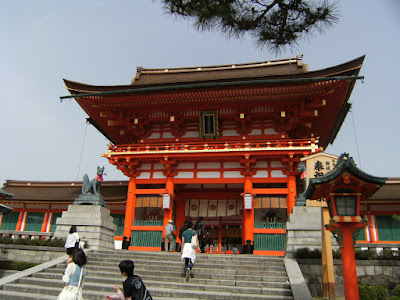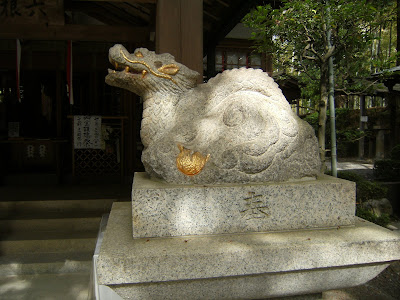The Inari shrines in particular are to worship the god of rice (who is named, incidentally, "Inari"). Ever since I'd seen a picture of a torii gate, and photos of Fushimi Inari Shrine, I knew I wanted to visit it - long before I was ever in Osaka. Fushimi Inari Shrine is the main Inari shrine and is also the largest. It's located in Kyoto, less than a three minute walk from JR Nara Line Inari Station. It took us about an hour and a half to get there from Suita, and that included at least 2 station changes, one of which included a fifteen minute walk from one station to the next. I am sure now that there is an easier way, as I've since gone to Kyoto with a group (who knew what they were doing), but at the time, it was learn-as-you-go. I had originally intended to go to Fushimi Inari solo, because I sort of wanted a break from being part of a group effort for everything. Nothing personal, to be sure, but I've got a bit of the loner spirit and sometimes I just don't want to worry about anyone else. Weeeellllll Meaghan said she'd always wanted to see the fox statues at Fushimi, and so I figured, what the hell. Meaghan's very easy to get along with and as long as I wasn't having to herd multiple people along, I figured it'd be fine.
Together, we braved the train stations and the confusing-as-hell map:

We eventually got to the right place. I hate the JR line with a passion because they use Kanji constantly and unlike most train stations, don't use furigana above the Kanji so those of us who can read Hiragana can at least get by. I mean, I'm not asking for English or anything, just Hiragana so I can pick up the Kanji I don't know. The worst part about this is the JR line goes to most touristy destinations, so you'd think they would be a little more accommodating, but noooo.
Anyway, Fushimi Inari shrine is quite beautiful:
Of course there is more shrine water:
And a sign explaining how to clean your hands and drink the water before entering the shrine (though I don't believe it's required). It's worth noting that the Japanese read from right to left, so the instructions begin on the right side:
As aforementioned, Inari is the God of rice, and there are many statues of foxes around the shrine. I was doing some reading and apparently many of the foxes have keys in their mouths, which are supposed to be keys to the rice granary. This fox has some sort of sphere in his mouth though. I can't find what the sphere represents, so I'm going to make something up; here's a statue of a fox someone was playing fetch with!
Main entrance to the shrine:
There were some shops there, and we did some light shopping. I picked up a glass bell with some fish painted on it that I liked the sound of. We decided to come back to the shops on the way down though, and started up into the shrine. The shrine itself is at the base of a mountain, but you climb quite a ways (via about 10,000,000 stairs) to a higher vantage point. The entire journey you're surrounded by thousands upon thousands of Torii gates. We began our ascent:
Here are some of the shots I like best from Fushimi:
(A path diverged in the woods and... we took the left one!)
There's more gates here than Bill Gates' family reunion! Or something. Anyway, as you can see one side of the gates is blank and the other side (the side you see when you head back down the mountain) has text on it. The gates are all donated by Japanese companies, and the text has the company names and sometimes a slogan (I believe) on it. But since it's Japanese writing, I'm sure to most foreigners it just looks neat (and because much of it is in Kanji, I'm one of those foreigners).
I'm sure it's hard to understand my hatred for Kanji, but let's do a little experiment, shall we? Grab a pencil and piece of paper and pull up a chair. Try to write the name of Fushimi Inari Shrine in standard-sized handwriting (I'll even make it bigger so it's easier to see):
伏見稲荷大社
Ok, have you given that a shot? Are you ready to commit honorable seppuku yet? Because I almost am, and all-in-all that Kanji is relatively simple compared to many others (for example, 料理, which means cooking, and makes me want to claw my eyes out because it takes about fifty tries for me to write it properly). Oh, and by the way, each individual Kanji has a thing called stroke order, which is the specific, proscribed order in which each line within a single character is to be written in. You can't just write it as you please, all willy-nilly with your Western-style individualism! That's insulting! Oh, and they CAN tell if it's not written in correct order. That said, I have been writing it a lot more lately and I think I'm getting better at it. At least the ones I use frequently. I have 私 (me, I) down!
Er... sorry about that little tangent. Anyway, the torii gates are quite pretty and brightly colored. The mountain air was cool and soothing, and the whole of the shrine is a pretty peaceful place. You need peaceful places. For meditation. And you need meditation because you spent half the day writing Kanji........
The path up the mountain is not a straight-away, and there are many diversions and split paths that one can take. We by no means saw the entirety of the shrine because it's quite large. The trek to the top took about two hours though, and we didn't take all the side paths that we could have. Along the way here and there were shops and restaurants, and I imagine there must be some kind of back-road because we did see a small truck there, tucked in among the torii gates:
The path up the mountain is not a straight-away, and there are many diversions and split paths that one can take. We by no means saw the entirety of the shrine because it's quite large. The trek to the top took about two hours though, and we didn't take all the side paths that we could have. Along the way here and there were shops and restaurants, and I imagine there must be some kind of back-road because we did see a small truck there, tucked in among the torii gates:
One of the small mini-shrines had something called a "heavy-light stone." Here's how it works:
And the stone is pictured here on the pedestal in the middle:
Various shrine photos:
The scenery was also nice, although to be fair being from Texas, I am impressed by anything green:
More gates!
Obligatory shrine kitteh:
We finally did reach the top, and it was a bit of a foggy day unfortunately. We took a break and had some ice cream, and I got some shots of the "view:"
I snagged this pic off the internet though, of what the view looks like on a clear day:
Eventually, we headed back down and towards the station. We found a mall with some interesting signage:
And we had dinner at a Teppanyaki place, I have both a pic of dinner and a video, so you can hear and see it sizzling! It was basically just pork and veggies in a sweet and tangy sauce. Meaghan ordered something that was "spicy" but most spicy things in Japan fall flat, so she was surprised when it was actually REALLY spicy. Lesson learned!
And that's the day I spent in Kyoto, visiting Fushimi-Inari Taisho!

















































